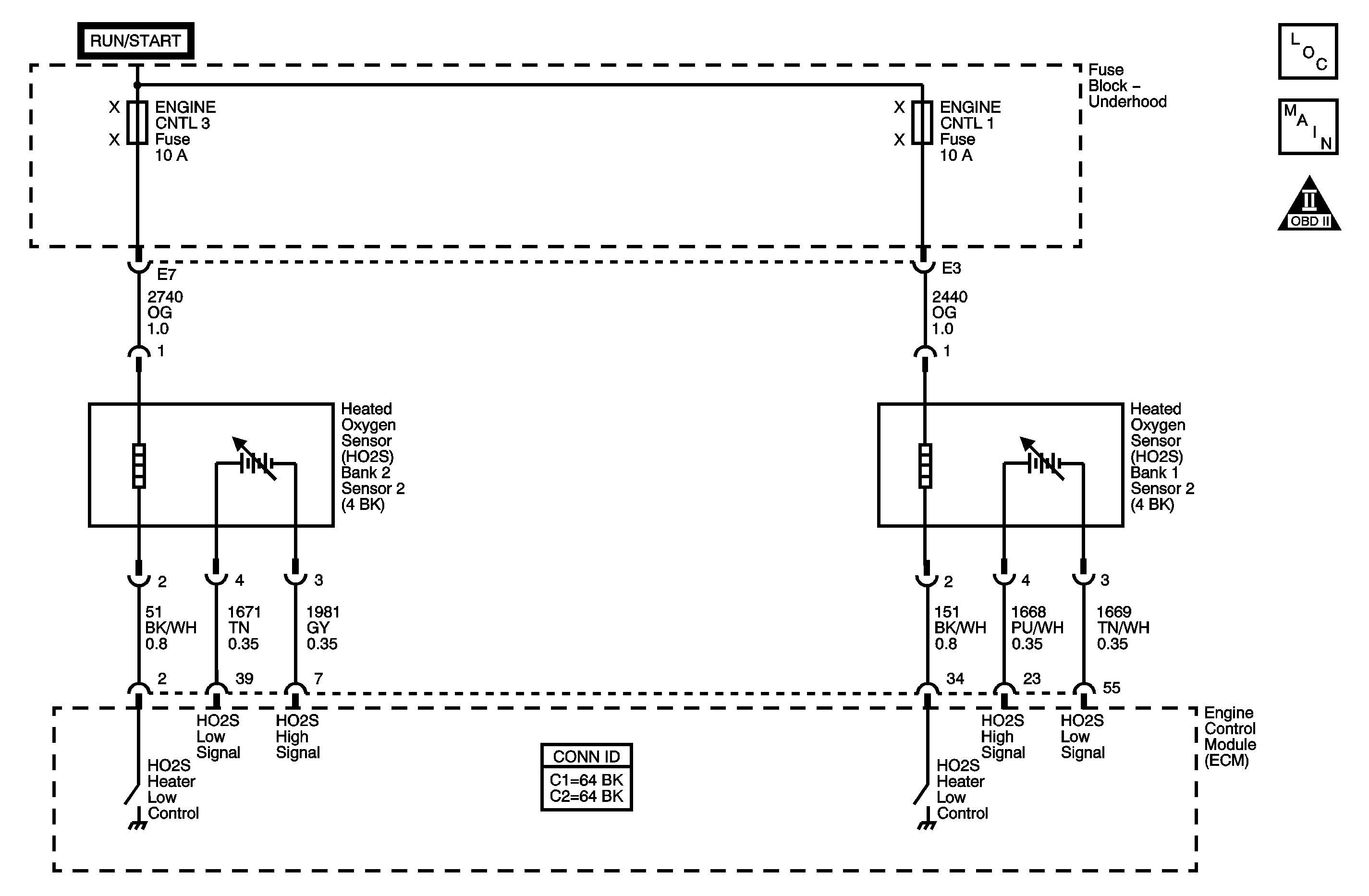
Circuit Description
Heating elements inside the heated oxygen sensor (HO2S) minimize the time required for the sensors to reach operating temperature and provide an accurate voltage signal. A low side driver within the engine control module (ECM) is pulse width controlled to provide variable current to the heater elements. During warm-up the ECM will reduce the ON time to prevent thermal shock to the sensor components from moisture in the exhaust system. The ECM will not allow full HO2S heating until calibrated limits of time, temperature, and intake airflow have been reached. The ECM periodically monitors the HO2S heater operating state by briefly turning OFF the heater low side driver at regular intervals. A small reference voltage is present at the heater low control circuit. When the low side driver is commanded ON, the reference voltage is low, 1.6-3.6 volts. When the low side driver is commanded OFF, the reference voltage is high, close to battery voltage. If the ECM detects that the HO2S heater low control circuit voltage is between 1.6-3.6 volts when the heater is commanded OFF, DTC P0037 will set for bank 1 sensor 2 or DTC P0057 will set for bank 2 sensor 2.
Conditions for Running the DTC
| • | The Engine Speed parameter is more than 40 RPM. |
| • | The Battery Voltage parameter is 10.5-17.3 volts. |
Conditions for Setting the DTC
The ECM detects that the HO2S heater low control circuit voltage is below 3.6 volts for more than 0.5 seconds when the heater is commanded OFF, indicating a HO2S heater circuit shorted to ground.
Action Taken When the DTC Sets
| • | The control module illuminates the malfunction indicator lamp (MIL) on the second consecutive ignition cycle that the diagnostic runs and fails. |
| • | The control module records the operating conditions at the time the diagnostic fails. The first time the diagnostic fails, the control module stores this information in the Failure Records. If the diagnostic reports a failure on the second consecutive ignition cycle, the control module records the operating conditions at the time of the failure. The control module writes the operating conditions to the Freeze Frame and updates the Failure Records. |
Conditions for Clearing the MIL/DTC
| • | The control module turns OFF the malfunction indicator lamp (MIL) after 3 consecutive ignition cycles that the diagnostic runs and does not fail. |
| • | A current DTC, Last Test Failed, clears when the diagnostic runs and passes. |
| • | A history DTC clears after 40 consecutive warm-up cycles, if no failures are reported by this or any other emission related diagnostic. |
| • | Clear the MIL and the DTC with a scan tool. |
Step | Action | Yes | No |
|---|---|---|---|
Schematic Reference: Engine Controls Schematics Connector End View Reference: Engine Controls Connector End Views or Engine Control Module Connector End Views | |||
1 | Did you perform the Diagnostic System Check-Engine Controls? | Go to Step 2 | |
2 |
Does the DTC fail this ignition? | Go to Step 4 | Go to Step 3 |
3 |
Did the DTC fail this ignition? | Go to Step 4 | Go to Intermittent Conditions |
4 |
Important: Use a known good ground. Do not use the heated oxygen sensor (HO2S) heater low control circuit or HO2S low signal circuit.
Does the test lamp illuminate? | Go to Step 5 | Go to Step 9 |
5 |
Does the test lamp flash ON and OFF? | Go to Step 7 | Go to Step 6 |
6 | Test the affected HO2S heater low control circuit for a short to ground. Refer to Circuit Testing and Wiring Repairs in Wiring Systems. Did you find and correct the condition? | Go to Step 12 | Go to Step 8 |
7 | Test for poor connections and shorted terminals at the harness connector of the HO2S. Refer to Testing for Intermittent Conditions and Poor Connections and Connector Repairs in Wiring Systems. Did you find and correct the condition? | Go to Step 12 | Go to Step 10 |
8 | Test for poor connections and shorted terminals at the harness connector of the engine control module (ECM). Refer to Testing for Intermittent Conditions and Poor Connections and Connector Repairs in Wiring Systems. Did you find and correct the condition? | Go to Step 12 | Go to Step 11 |
9 | Repair the open or high resistance of the affected HO2S heater ignition 1 voltage circuit. Refer to Circuit Testing and Wiring Repairs in Wiring Systems. Did you complete the repair? | Go to Step 12 | -- |
10 | Replace the affected HO2S. Refer to Heated Oxygen Sensor Replacement - Bank 1 Sensor 2 and Heated Oxygen Sensor Replacement - Bank 2 Sensor 2 . Did you complete the replacement? | Go to Step 12 | -- |
11 | Replace the ECM. Refer to Engine Control Module Replacement . Did you complete the replacement? | Go to Step 12 | -- |
12 |
Did the DTC fail this ignition? | Go to Step 2 | Go to Step 13 |
13 | Observe the Capture Info with a scan tool. Are there any DTCs that have not been diagnosed? | System OK | |
